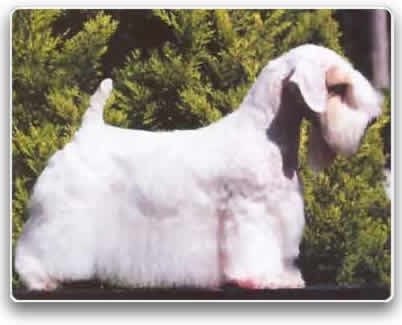Terriers
Terriers in TroubleAlthough dog-ownership in Britain is relatively stable, with estimates suggesting a canine population of around 6.6 million dogs, this figure masks a growing crisis. There are now nearly 30 native breeds which are in real danger of dying out. This includes some 13 types of terrier, equating to half of all the breeds in their group.
Breed registration figures compiled annually by the Kennel Club reveal the scale of the problem and highlight the changing preferences of owners. During the 1930s, the Sealyham terrier was one of the most popular and fashionable of all breeds, finding favour with movie stars ranging from Humphrey Bogart to Elizabeth Taylor.
But its numbers have dipped to such an extent that just 43 were registered by breeders nationwide last year. As a result, the Sealyham terrier is now ranked as one of the three most endangered dog breeds in Britain.
Success for the Sealyham

Sealyhams might have been thought to benefit from the breed’s success at Crufts in 2009. Champion Efbe's Hidalgo at Goodspice, better-known as Charmin, ended up not only winning the terrier group but was also judged top dog out of the 22,000 entries at the show, thereby scooping the coveted Best-in-Show title.
In the past, a win of this type at the UK’s premier show would have guaranteed a significant boost in interest in the breed, given the attendant publicity, but this no longer the case. The Kerry blue terrier which is another of the breeds currently under threat gained no obvious benefit of this type from winning this award in 2000.
There are also some surprises on the list of endangered breeds, such as the inclusion of the bloodhound. It is one of the most distinctive and iconic of all breeds but is becoming increasing imperiled in the UK. Other larger breeds in the hound category, such as the otterhound and deerhound are also struggling to attract attention again, now that they are no longer kept for their original working purposes. This applies even in the USA, where there is generally more space to keep larger dogs.
A changing world
Part of the problem may reside with the temperament and ancestry of these breeds. All of those on the endangered list are working dogs. This means that they are not necessarily as suited to being kept as pets when compared with many of the popular smaller toy breeds of today, such as the Chihuahua or the Cavalier King Charles spaniel. Furthermore, the grooming of many terriers often requires professional assistance, particularly for the show ring, which can be a deterrent to novice exhibitors as well as would-be pet-seekers, because of the additional expense.
The irony is that the numbers of breeds recognized by the Kennel Club for show purposes in the UK today has never been higher and yet the percentage which can be regarded as endangered is equally at an all-time high. One of the moves being advocated by the British and Irish Dog Breeds Preservation Trust is to create a Red List, of those which are perceived to be the most critically endangered. This, so the organization believes, will raise awareness about the plight of such dogs and help to improve the situation.
A similar approach has worked well in the UK for native breeds of farm animal under threat, which feature on a list drawn up by the Rare Breeds Survival Trust. The Budgerigar Society has also operated a scheme for rare color varieties which has been well-supported.
There are some encouraging signs of just what can be achieved in the dog world too, particularly when it comes to saving endangered breeds. The Chinese Shar-Pei as an example had virtually died out in its homeland when a Hong Kong dog enthusiast wrote about its situation in the US dog press. This in turn led to the breed being imported to the USA, and subsequently establishing the worldwide following which it enjoys today.
Ironically, as the range of dog breeds which have recently been introduced to both North America and Britain has grown significantly however, so more traditional breeds seem to have lost out. While the number of Shar-Peis registered in 2007 by the American Kennel Club (AKC) was 3,544, this figure contrasts with just 44 otterhounds.
A global effort
Those publicising the plight of these endangered British breeds hope that dog fanciers in North America and elsewhere may also help to increase their numbers. All of them have AKC recognition, having been represented at shows there for many years. In fact, Charmin the Sealyham terrier was actually bred in North America, and brought over specially for Crufts, before returning home.
The registration figures in the USA currently make depressing reading however, with these breeds having undergone a similar fall from fashion. Sealyham terriers rank 152nd, with only Dandie Dinmonts in the terrier group beneath them in 164th place, on the list of the 167 breeds registered by the AKC last year.
In terms of giving practical assistance towards safeguarding the future of such dogs, the answer may be something as simple as a dog food manufacturer deciding to provide support for these endangered breeds by offering additional prizes for them at shows. This could serve to promote interest and raise their profile again. They represent an important part of the world’s canine heritage and must not be allowed to die out.